In Short:
Girls Band Cry is a 13 episode anime from 2024 made by Toei Animation that follows five girls as they try and come together as a professional independent rock band. It’s five main characters are all quirky and real with their own hangups and somewhat troubled pasts they work to overcome. While there is some serious drama, the show avoids becoming gritty or depressing. Instead, it’s a delight to see these characters squabble and fight and bounce off each other but still become good friends in the end.
Suggested Minimum Watch: 1 episode. While you don’t really meet the full set of main characters till roughly the midway point, episode 1 does a good job showcasing the show’s style of drama, humor, quirkiness, and features a strong showing of its approach to its tightly produced Rock n’ Roll musical numbers. If you like the first episode, you’ll like the rest of the show.
Full Review:
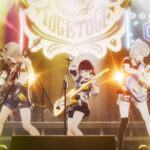 I almost didn’t watch Girls Band Cry because of the way it debuted and because of the way I approach music. For me, music is something that has to be connected to other things. I’ll enjoy the heck out of songs if they are connected to a show or movie or even just a moment in life that I love, but I almost never seek out music for its own sake. So when Girls Band Cry started by first releasing music videos almost a year before the anime came out I pretty much ignored the songs and didn’t plan on watching the anime. The music alone just didn’t mean anything to me. But then, a year later, I happened to give the first episode of the anime a chance and was hooked! Perhaps it’s not my favorite anime of all time, but I consider it one of my standouts in recent years.
I almost didn’t watch Girls Band Cry because of the way it debuted and because of the way I approach music. For me, music is something that has to be connected to other things. I’ll enjoy the heck out of songs if they are connected to a show or movie or even just a moment in life that I love, but I almost never seek out music for its own sake. So when Girls Band Cry started by first releasing music videos almost a year before the anime came out I pretty much ignored the songs and didn’t plan on watching the anime. The music alone just didn’t mean anything to me. But then, a year later, I happened to give the first episode of the anime a chance and was hooked! Perhaps it’s not my favorite anime of all time, but I consider it one of my standouts in recent years.
Girls Band Cry follows in the footsteps of Sound! Euphonium and A Place Further than the Universe in that all three are shows whose stories and characters were penned by Jukki Hanada. His style of writing that puts the personalities and actions of characters at the forefront just clicks with me. Characters’ good times and bad, their delights and dilemmas, their strengths and weaknesses, they all flow together that makes so many of his shows among my favorites.
For Girls Band Cry, we have five main characters who have each set out on their own in life for their own highly personal reasons.
 Our main viewpoint character is Nina Iseri. Early on, we learn she was plagued by some sort of bullying incident in high school and because it she convinced her parents to let her drop out and move away to Tokyo to live and study on her own for college. Nina can be sweet and devoted, but just as often she can be prickly, stubborn, and a lot to deal with.
Our main viewpoint character is Nina Iseri. Early on, we learn she was plagued by some sort of bullying incident in high school and because it she convinced her parents to let her drop out and move away to Tokyo to live and study on her own for college. Nina can be sweet and devoted, but just as often she can be prickly, stubborn, and a lot to deal with.
On her first bumbled day in the big city, Nina comes across a musician a few years older than her named Momoka Kawaragi. It turns out it was Momoka’s hit song “Void” that helped Nina get through the worst of her bullying. We soon learn that Momoka, for her own reasons, left her rising star of a band Diamond Dust and has tried but largely failed to strike out on her own. She lost things she didn’t expect when she left her band and she’s been unable to find them again.
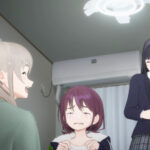 These two strike up a friendship with Momoka doing her best to pull the uncooperative Nina into a new band along with drummer Subaru Awa. Sabaru is an energetic delight, but she too wishes to strike out on her own. For her, it’s to buck the expectations one prominent member of her family has for her. Subaru wants the freedom to do her own thing, but knows she’ll hurt at least one of her most supportive family members when she does so.
These two strike up a friendship with Momoka doing her best to pull the uncooperative Nina into a new band along with drummer Subaru Awa. Sabaru is an energetic delight, but she too wishes to strike out on her own. For her, it’s to buck the expectations one prominent member of her family has for her. Subaru wants the freedom to do her own thing, but knows she’ll hurt at least one of her most supportive family members when she does so.
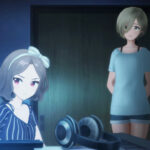 Later on, these three are joined by Tomo Ebizuka and Rupa. Like Subaru, Tomo is a girl roughly Nina’s age whose family let her down, so she left them behind. She is serious about making music her career, but struggles to work with those less serious than herself. Rupa, who is Tomo’s roommate, has her own sad past and, as a girl of mixed race, lives in a sometimes unpleasant present. So Rupa, like the others, has some reasons to let out her frustrations on a rock band stage.
Later on, these three are joined by Tomo Ebizuka and Rupa. Like Subaru, Tomo is a girl roughly Nina’s age whose family let her down, so she left them behind. She is serious about making music her career, but struggles to work with those less serious than herself. Rupa, who is Tomo’s roommate, has her own sad past and, as a girl of mixed race, lives in a sometimes unpleasant present. So Rupa, like the others, has some reasons to let out her frustrations on a rock band stage.
The ways these five fit together, or rather the ways they sometimes don’t, is what makes the show. Momoka pulls the five of them into her new band but then hesitates as things start to get real. Nina is constantly a lovable pain in the ass with the way she stubbornly rejects genuine offers of help or friendship. Subaru has to hide her identity on stage for fear of disappointing her family. Tomo thinks she’ll drive everyone away if she voices her real opinions on the others’ levels of skill and commitment, etc. The arguments and honest conversations that come out of these conflicting wants and needs can be fiery, but as Momoka explains early on, some of her best memories of being in a band were the fights with her friends. And so it is with the anime.
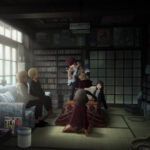 The five girls eventually settle down, learn each others habits and hangups, and do come together. There is drama here, but it’s not as heavy as the classic rock band anime NANA, for instance. Girls Band Cry remains generally lighthearted and while some situations can comes as a shock or take multiple episodes to resolve, the girls do eventually resolve them. The writing here is excellent. The personalities feel real. There’s some humor along the way, but it’s humor that fits in with the show instead of humor that is the show.
The five girls eventually settle down, learn each others habits and hangups, and do come together. There is drama here, but it’s not as heavy as the classic rock band anime NANA, for instance. Girls Band Cry remains generally lighthearted and while some situations can comes as a shock or take multiple episodes to resolve, the girls do eventually resolve them. The writing here is excellent. The personalities feel real. There’s some humor along the way, but it’s humor that fits in with the show instead of humor that is the show.
Animation and Music:
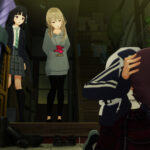 Girls Band Cry is a 3d CGI production, meaning most everything except the rare one off background character is done as computer animation. While the show generally lacks the overwhelmingly rich level of foreground and background detail something like a full blown Disney/Pixar movie has, Girls Band Cry does have its own strengths that become more apparent the more you watch. The show features a smooth, constant, 24 frames per second rate of animation. A lot of hand-drawn and CGI anime updates less frequently where Girls Band Cry updates the movements of its camera and characters every frame. In practice what this mean is every scene has something happening. Every character movement is smooth and detailed. From big sweeping gestures to the show’s frequent use of highly expressive facial reactions, everything is snappy and fluid in ways you might not expect from most 3d productions. Or from most traditional, hand-drawn anime for that matter.
Girls Band Cry is a 3d CGI production, meaning most everything except the rare one off background character is done as computer animation. While the show generally lacks the overwhelmingly rich level of foreground and background detail something like a full blown Disney/Pixar movie has, Girls Band Cry does have its own strengths that become more apparent the more you watch. The show features a smooth, constant, 24 frames per second rate of animation. A lot of hand-drawn and CGI anime updates less frequently where Girls Band Cry updates the movements of its camera and characters every frame. In practice what this mean is every scene has something happening. Every character movement is smooth and detailed. From big sweeping gestures to the show’s frequent use of highly expressive facial reactions, everything is snappy and fluid in ways you might not expect from most 3d productions. Or from most traditional, hand-drawn anime for that matter.
And this is surprising. At lot of 3d rendered shows skimp on this. Expressions often remained static and unchanging. Characters movements are sometimes jerky or or unnaturally stiff, especially when they aren’t the center of attention. Not so in Girls Band Cry. Its animation is actually really good! And consistently so! Which must have taken a ton of work all for a new, unknown, original anime based on nothing before it. There is no hundred issue manga funding this show.
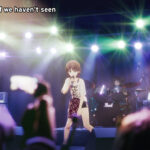 Finally, beyond the well-written characters and consistently good animation, there’s the rock music and the music sequences. Girls Band Cry’s music is influenced a lot by Nina’s experiences with bullying and feeling cut off. She sings about making tough choices. About feeling alone in crowds. About how patronizing it can be to tell someone to do their best but then tell them to fit in. And all this is held up by some of the very best music video type sequences in anime. There’s breathtakingly good motion capture of the girls playing instruments and singing. There’s fun, creative camera moves that pan, and snap and rotate and spin to the beat of the music.
Finally, beyond the well-written characters and consistently good animation, there’s the rock music and the music sequences. Girls Band Cry’s music is influenced a lot by Nina’s experiences with bullying and feeling cut off. She sings about making tough choices. About feeling alone in crowds. About how patronizing it can be to tell someone to do their best but then tell them to fit in. And all this is held up by some of the very best music video type sequences in anime. There’s breathtakingly good motion capture of the girls playing instruments and singing. There’s fun, creative camera moves that pan, and snap and rotate and spin to the beat of the music.
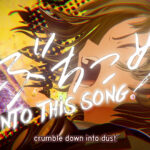 There’s a variety of cool effects from raindrops hanging in the air to pretend glass walls shattering as they are referenced in the lyrics, to the momentary color inversions during one particularly awesome guitar solo. These sequences generally serve as rewarding ends to episodes. Some are high flying moments, others are yelling about injustices in the world through song, but they’re all brilliant showpieces of music and animation working hand in had.
There’s a variety of cool effects from raindrops hanging in the air to pretend glass walls shattering as they are referenced in the lyrics, to the momentary color inversions during one particularly awesome guitar solo. These sequences generally serve as rewarding ends to episodes. Some are high flying moments, others are yelling about injustices in the world through song, but they’re all brilliant showpieces of music and animation working hand in had.
All In All
 Girls Band Cry is about learning to be yourself, learning when to reject help and when to accept it, learning how to fit in with others and address their wants and their fears alongside your own. And it’s about these five girls supporting each other and combining their strengths to accomplish something bigger than their individual selves. It’s fun and entertaining rather than being heavy and depressing, but it is not a comedy-first show the likes of K-On! or Bocchi The Rock!. Aside from its showcase on-stage rock sequences, it doesn’t necessarily do anything never seen before. If you’ve watched NANA, K-On!, Bocchi the Rock, Ya Boy Kongming, and other music anime then you’ve seen a lot of the building blocks that Girls Band Cry draws upon, but it combines them with good character writing in fun ways that ended up making it one of my favorite anime of 2024.
Girls Band Cry is about learning to be yourself, learning when to reject help and when to accept it, learning how to fit in with others and address their wants and their fears alongside your own. And it’s about these five girls supporting each other and combining their strengths to accomplish something bigger than their individual selves. It’s fun and entertaining rather than being heavy and depressing, but it is not a comedy-first show the likes of K-On! or Bocchi The Rock!. Aside from its showcase on-stage rock sequences, it doesn’t necessarily do anything never seen before. If you’ve watched NANA, K-On!, Bocchi the Rock, Ya Boy Kongming, and other music anime then you’ve seen a lot of the building blocks that Girls Band Cry draws upon, but it combines them with good character writing in fun ways that ended up making it one of my favorite anime of 2024.
[…] Review: Girls Band Cry […]